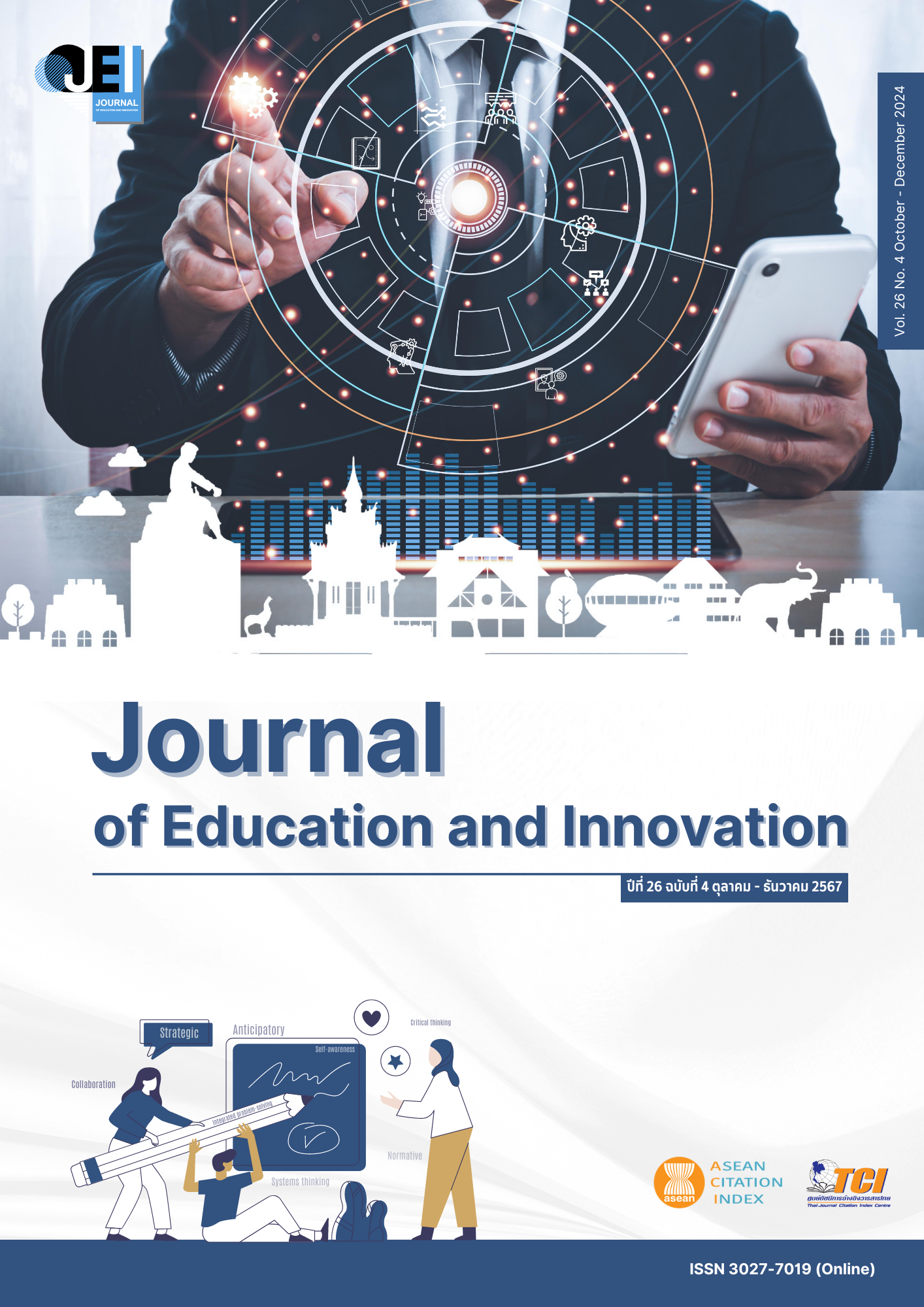BIOMIMICRY DESIGN SPIRAL INSTRUCTIONAL METHOD FOR SCIENCE TEACHER
Main Article Content
Abstract
This article introduces a new instructional method for learning management that incorporates the concept of biomimicry design spiral or designs inspired by nature. The method aims to motivate students to apply their scientific knowledge related to living things and ecosystems to tackle human problems. The article provides valuable information for science teachers who wish to use this learning management method in their teaching and learning practices. It covers the history of design inspired by nature, the biomimicry design spiral concept, examples of learning management activities based on the biomimicry design spiral concept instructional method, evaluation of learning outcomes, and suggestions for implementation in a classroom.
Article Details

This work is licensed under a Creative Commons Attribution-NonCommercial-NoDerivatives 4.0 International License.
The owner of the article does not copy or violate any of its copyright. If any copyright infringement occurs or prosecution, in any case, the Editorial Board is not involved in all the rights to the owner of the article to be performed.
References
Arora, A., & McIntyre, J. R. (2021). Biogeneration Bio-Inspired Architecture for Regenerative Built Environments. Journal of Civil Engineering and Architecture, 6(7), 1-16.
Awae, M., Duangratanaekachai, S., Faikhamta, C., & Pongsophon, P. (2023). Biomimicry Design Spiral Learning Management: STEM Education in Biology Classroom. Journal of Education Prince of Songkla University, 34(3), 1-12.
Awae, M., Worakitchanon, Y., Sakpirom, P., & Pongsopon, P. (2019). Teaching Nature of Technology in Modern Science Classroom by Engineering Design Process. Journal of Education Studies, 47(3), 309-327.
Benyus, J. M. (1997). Biomimicry: Innovation inspired by nature. New York: Morrow.
Biomimicry Institute. (2017). The Biomimicry Design Process. Retrieved December 23, 2023, from https://toolbox.biomimicry.org/methods/process.
Biomimicry Institute. (2020). Biomimicry Youth Design Challenge Rubric, v4.0. Retrieved December 23, 2023, from https://www.youthchallenge.biomimicry.org/challenge-details.
Coban, M., & Costu, B. (2021). Integration of biomimicry into science education: biomimicry teaching approach. Journal of Biological Education, 55(1), 1-25.
Distaporn, S., Sompoangeon, S., & Wangcharoen, V. (2022). The Creation of Products from the Concept of Biomimicry: A Case Study of Vegetable Grow Kit. Journal of Fine Arts Research and Applied Arts, 9(1), 111-136.
Faikhamta, C., Awae, M., Suknarusaithagul, N., & Mutcha, P. (2023). Research Trends in STEM Education in Thailand. CMU Journal of Education, 7(1), 29-43.
Gvili, I. E., Weissburg, M. J., Yen, J., Helms, M. E., & Tovey, C. A. (2016). Development of scoring rubric for evaluating integrated understanding in an undergraduate biologically-inspired design course. International Journal of Engineering Education, 32, 123-135.
Mejía-Villa, D. A., Torres-Guevara, D. L., Prieto-Sandoval, D. V., Cabra, D. J., & Jaca, D. C. (2023). Training for Sustainability through Biomimicry and Creative Problem-Solving Processes. Thinking Skills and Creativity, 49, 1-17.
Ministry of Education. (2023). Announcement of the Ministry of Education on Educational Policy of the Ministry of Education Fiscal year 2024 – 2025. Retrieved January 31, 2024, from https://moe360.blog/2023/12/06/p55122.
Nkandu, M. I., & Alibaba, H. Z. (2018). Biomimicry as an Alternative Approach to Sustainability. Architecture Research, 8(1), 1-11.
OECD. (2023). PISA 2022 Results (Volume I): The State of Learning and Equity in Education. PISA, OECD Publishing: Paris.
Okeke, F. O., Okekeogbu, C. J., & Adibe, F. A. (2017). Biomimicry and Sustainable Architecture: A Review of Existing Literature. Journal of Environmental Management and Safety, 8(1), 11-24.
Park, J. K., & Kim, S. (2019). Three-Dimensionally Structured Flexible Fog Harvesting Surfaces Inspired by Namib Desert Beetles. Micromachines, 10, 201.
Pathak, S. (2019). Biomimicry: (Innovation Inspired by Nature). International Journal of New Technology and Research, 5(6), 34-38.
Pedersen Zari, M., & Storey, J. B. (2007). An ecosystem based biomimetic theory for a regenerative built environment. Lisbon Sustainable Building Conference 07, Lisbon, Portugal.
Putwattana, N. (2018). Engineering Design and Biomimicry in STEM Education. STOU Education Journal, 11(2), 31-42.
Qureshi, S. (2020). How students engage in biomimicry. Journal of Biological Education, 56(4), 450-464
Sahil, M., & Kothari, P. (2020). Case Study on Architecture of Lotus Temple. International Journal of Engineering Research & Technology, 9(5), 1355-1360.
Sankaewthong, S., Horanont, T., Miyata, K., Karnjana, J., Busayarat, C., Xie, H. (2022). Using a Biomimicry Approach in the Design of a Kinetic Façade to Regulate the Amount of Daylight Entering a Working Space. Buildings, 12, 1-26.
Storey, J. B., & Pedersen Zari, M. (2006). Factor X - well being as a key component of next generation green buildings. Rethinking Sustainable Construction Conference, Sarasota, FL.
The Institute for the Promotion of Teaching Science and Technology (IPST). (2015). STEM education standards. Bangkok: IPST.
The Institute for the Promotion of Teaching Science and Technology (IPST). (2023). PISA 2022 results. Retrieved January 28, 2024, from https://pisathailand.ipst.ac.th/news-21.
Turner, J. S., & Soar, R. (2008). Beyond biomimicry: what termites can tell us about realising the living building. 1st International Conference on Industrialised, Intelligent Construction. Loughborough University, UK.
Vasinayanuwatana, T., & Vanichanon, A. (2022). Biomimicry: An Alternative Way of STEM Education in Biology. Journal of Education Prince of Songkla University, 33(1), 1-11.
Verbrugghe, N., Rubinacci, E., & Khan, A. Z. (2023). Biomimicry in Architecture A Review of Definitions, Case Studies, and Design Methods. Biomimetics, 8, 107, 1-29.


